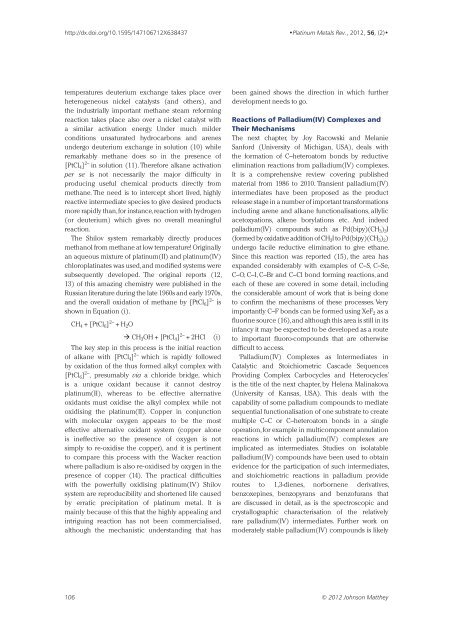Download article PDF - Platinum Metals Review
Download article PDF - Platinum Metals Review
Download article PDF - Platinum Metals Review
Create successful ePaper yourself
Turn your PDF publications into a flip-book with our unique Google optimized e-Paper software.
http://dx.doi.org/10.1595/147106712X638437<br />
•<strong>Platinum</strong> <strong>Metals</strong> Rev., 2012, 56, (2)•<br />
temperatures deuterium exchange takes place over<br />
heterogeneous nickel catalysts (and others), and<br />
the industrially important methane steam reforming<br />
reaction takes place also over a nickel catalyst with<br />
a similar activation energy. Under much milder<br />
conditions unsaturated hydrocarbons and arenes<br />
undergo deuterium exchange in solution (10) while<br />
remarkably methane does so in the presence of<br />
[PtCl 4 ] 2– in solution (11). Therefore alkane activation<br />
per se is not necessarily the major difficulty in<br />
producing useful chemical products directly from<br />
methane. The need is to intercept short lived, highly<br />
reactive intermediate species to give desired products<br />
more rapidly than, for instance, reaction with hydrogen<br />
(or deuterium) which gives no overall meaningful<br />
reaction.<br />
The Shilov system remarkably directly produces<br />
methanol from methane at low temperature! Originally<br />
an aqueous mixture of platinum(II) and platinum(IV)<br />
chloroplatinates was used, and modified systems were<br />
subsequently developed. The original reports (12,<br />
13) of this amazing chemistry were published in the<br />
Russian literature during the late 1960s and early 1970s,<br />
and the overall oxidation of methane by [PtCl 6 ] 2– is<br />
shown in Equation (i).<br />
CH 4 + [PtCl 6 ] 2– + H 2 O<br />
CH 3 OH + [PtCl 4 ] 2– + 2HCl (i)<br />
The key step in this process is the initial reaction<br />
of alkane with [PtCl 4 ] 2– which is rapidly followed<br />
by oxidation of the thus formed alkyl complex with<br />
[PtCl 6 ] 2– , presumably via a chloride bridge, which<br />
is a unique oxidant because it cannot destroy<br />
platinum(II), whereas to be effective alternative<br />
oxidants must oxidise the alkyl complex while not<br />
oxidising the platinum(II). Copper in conjunction<br />
with molecular oxygen appears to be the most<br />
effective alternative oxidant system (copper alone<br />
is ineffective so the presence of oxygen is not<br />
simply to re-oxidise the copper), and it is pertinent<br />
to compare this process with the Wacker reaction<br />
where palladium is also re-oxidised by oxygen in the<br />
presence of copper (14). The practical difficulties<br />
with the powerfully oxidising platinum(IV) Shilov<br />
system are reproducibility and shortened life caused<br />
by erratic precipitation of platinum metal. It is<br />
mainly because of this that the highly appealing and<br />
intriguing reaction has not been commercialised,<br />
although the mechanistic understanding that has<br />
been gained shows the direction in which further<br />
development needs to go.<br />
Reactions of Palladium(IV) Complexes and<br />
Their Mechanisms<br />
The next chapter, by Joy Racowski and Melanie<br />
Sanford (University of Michigan, USA), deals with<br />
the formation of C–heteroatom bonds by reductive<br />
elimination reactions from palladium(IV) complexes.<br />
It is a comprehensive review covering published<br />
material from 1986 to 2010. Transient palladium(IV)<br />
intermediates have been proposed as the product<br />
release stage in a number of important transformations<br />
including arene and alkane functionalisations, allylic<br />
acetoxyations, alkene borylations etc. And indeed<br />
palladium(IV) compounds such as Pd(bipy)(CH 3 ) 3 I<br />
(formed by oxidative addition of CH 3 I to Pd(bipy)(CH 3 ) 2 )<br />
undergo facile reductive elimination to give ethane.<br />
Since this reaction was reported (15), the area has<br />
expanded considerably with examples of C–S, C–Se,<br />
C–O, C–I, C–Br and C–Cl bond forming reactions, and<br />
each of these are covered in some detail, including<br />
the considerable amount of work that is being done<br />
to confirm the mechanisms of these processes. Very<br />
importantly C–F bonds can be formed using XeF 2 as a<br />
fluorine source (16), and although this area is still in its<br />
infancy it may be expected to be developed as a route<br />
to important fluoro-compounds that are otherwise<br />
difficult to access.<br />
‘Palladium(IV) Complexes as Intermediates in<br />
Catalytic and Stoichiometric Cascade Sequences<br />
Providing Complex Carbocycles and Heterocycles’<br />
is the title of the next chapter, by Helena Malinakova<br />
(University of Kansas, USA). This deals with the<br />
capability of some palladium compounds to mediate<br />
sequential functionalisation of one substrate to create<br />
multiple C–C or C–heteroatom bonds in a single<br />
operation, for example in multicomponent annulation<br />
reactions in which palladium(IV) complexes are<br />
implicated as intermediates. Studies on isolatable<br />
palladium(IV) compounds have been used to obtain<br />
evidence for the participation of such intermediates,<br />
and stoichiometric reactions in palladium provide<br />
routes to 1,3-dienes, norbornene derivatives,<br />
benzoxepines, benzopyrans and benzofurans that<br />
are discussed in detail, as is the spectroscopic and<br />
crystallographic characterisation of the relatively<br />
rare palladium(IV) intermediates. Further work on<br />
moderately stable palladium(IV) compounds is likely<br />
106 © 2012 Johnson Matthey
















